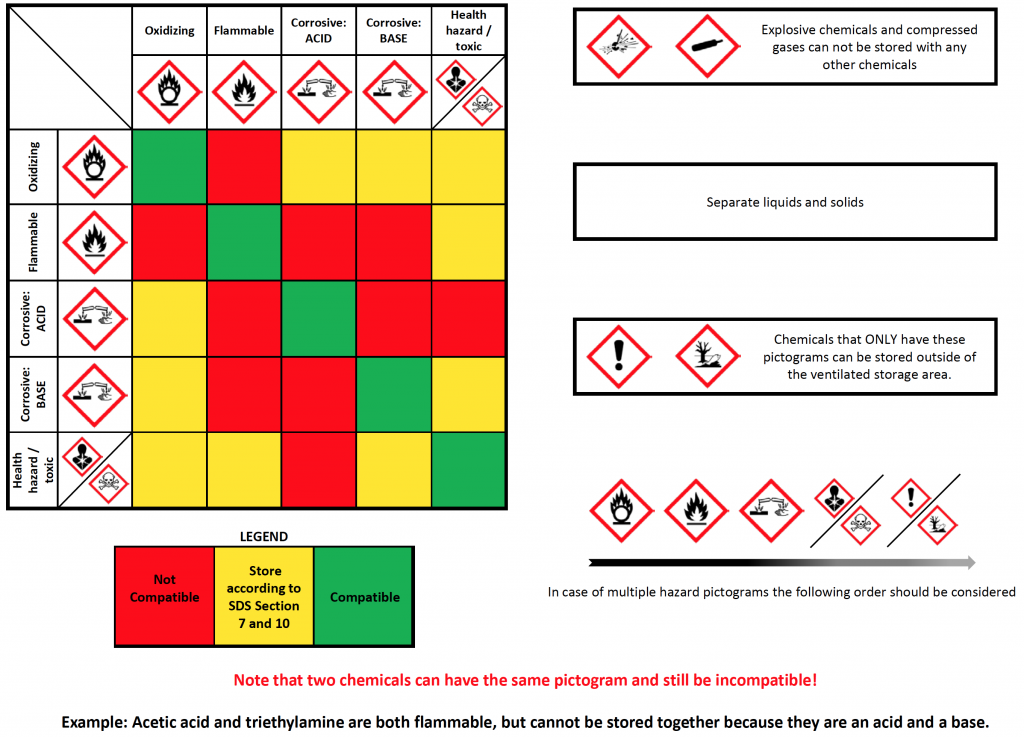Correct chemical storage can avoid reactions between incompatible materials with the potential to cause harm, fire or even explosions.
Safe storage of chemicals can be achieved by arranging the materials according to the hazard class (GHS pictogram) and then separating them based on their chemical properties. This requires planning and will involve an inventory, accurate labelling, an evaluation of chemical incompatibilities and a range of suitable containers and storage facilities.
In essence, the most important reasons for proper chemical storage are:
- to minimize exposure of the human, the environment and the infrastructure to corrosive and toxic chemicals
- to reduce the risk of fire and explosions
- to provide for effective management of chemicals and to compartmentalize and signal high risk areas
- to prevent accidental mixing of chemicals
- to comply with relevant statutory security obligations
We give you four basic rules and some general information to guide you to safely organize your chemical storage and to comply with legal requirements.
- Separate liquid from solid chemicals
- Organize your storage according to the GHS pictograms: check the Hazardous chemicals storage workflow (see Useful documents below)
- Respect the incompatibilities: check SDS section 7 and 10 and compare with the chemical incompatibilities table below
- Control the stock with rotation of material:
- e.g. marking with ‘use by’ or ‘date opened’
- periodic clear-outs
- inventory updates once a year

- Limit the amount of chemicals stored
- Keep chemicals in their original containers
- Keep bottles in the upright position
- Ensure the caps and lids are tightly closed, use caps with a pressure relief valve if there is a risk of overpressure
- Label all containers in the lab
- Make sure all labels are legible and in good condition
- Repair or replace damaged or missing labels
- Label chemicals properly according to the guidelines below
- Mark the storage location on the containers
- Do not store chemicals in alphabetical order except within the “Chemical Storage Groups”. Alphabetical arrangement of randomly collected chemicals often increases the likelihood of dangerous reactions by bringing incompatible materials into close proximity
- Physically separate acids and bases
- Look at sections 7 and 9 in the SDS for specific information of the storage conditions of each chemical
- Do not stockpile chemicals
- Use a retention tray for liquids. This containment should account for 100% the volume of the largest container e.g. if the largest container holds 1l then the containment should hold at least 1l
- Store liquid chemicals below eye level
- Avoid exposure of chemicals to direct sunlight or heat
- Do not store flammables in cold rooms which are neither ventilated nor explosion proof
- Peroxide forming chemicals must be stored in cabinets for flammable chemicals and must be inventoried regularly to track their age
- Return chemicals to the storage location after each use
- Discard chemicals that are no longer used/needed or that have expired (no longer than 5 years)
- Do not store stock supplies of chemicals on benchtops where they are unprotected from ignition sources and more easily knocked over
- Only chemicals in use should be on the benchtops
- Label storage rooms, cupboards and bins with the corresponding hazard triangle (black/yellow stickers)
Do not store chemicals in the fume hood: they may interfere with air flow in the hood
The labels must always be legible and must be exchanged when necessary. No writing on the original packaging label is allowed.
- Commercial products
All commercial products are labelled with a barcode when they arrive to the EPFL shop. The barcode includes information about the owner and the place of storage.
- Your mixtures, synthesized products and samples
All mixtures, products or samples you may synthesize need a label. The label must contain the following information:
- The name of the product
- Your name
- The date of preparation
- The solvent
- The corresponding hazard pictograms, if classified by GHS
Don’t use acronyms, write the full name to avoid confusion. In the case of several samples of the same type stored in a box or a rack it is enough to put the label with this information on the box/rack.
Preprinted labels are available in the shop.
The chemical storage online training provides the basic storage rules and EPFL guidelines, and gives you some tips on how to best organise the storage of your chemicals.